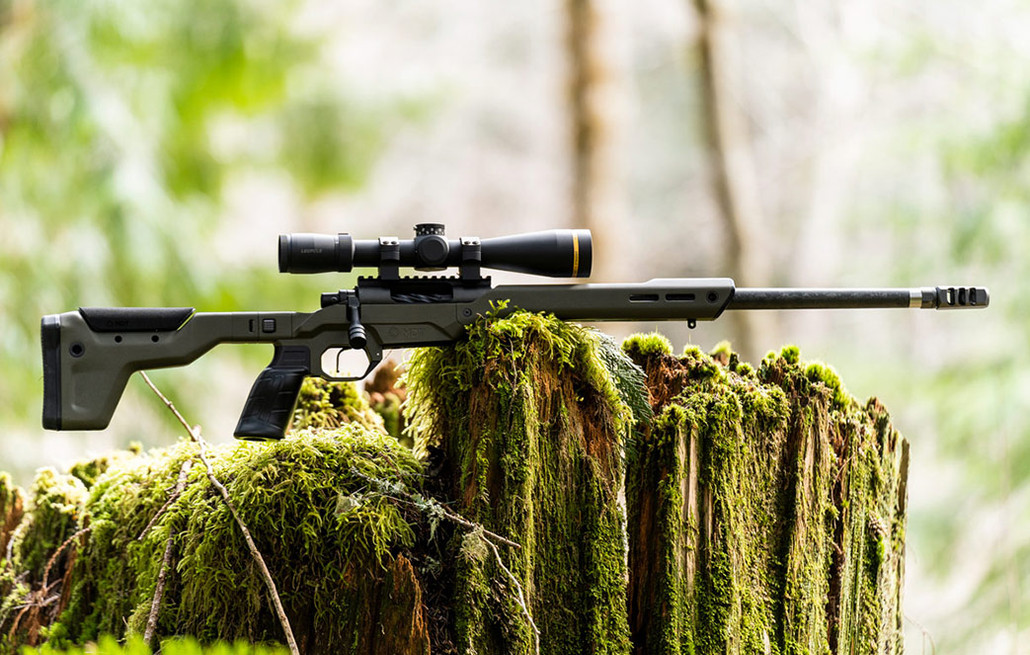Posted by Adam Scepaniak on 2021 Dec 16th
Intro to Muzzle Devices: Pros and Cons
Hunting season is upon us, which means hunters are sorting out their kits and getting their rifles zeroed and ready. One item to consider is what kind of muzzle device (if any) you will be taking into the field with you? Muzzle devices like muzzle brakes, blast diffusers, or suppressors have pros and cons, which we will look at in this article.
MUZZLE BRAKES
A common muzzle device seen on hunting and competition rifles is a muzzle brake. Their intended purpose is to vent the gasses propelling your bullet out of the barrel in a direction that will significantly mitigate recoil and, in some cases, muzzle rise. Brakes can be tremendously valuable for taking large hunting cartridges and making them more manageable to shoot, or even short action cartridges and negating pretty much all felt recoil. A good muzzle brake can subdue the muzzle rise enough that you can see your impacts on your intended target through your scope—which quickly lets you know if you got a successful hit, miss or if you need a second shot.

Muzzle brakes are very common on competition rifles.
A downside to muzzle brakes is that they can be deafening and cause permanent hearing loss if you do not wear hearing protection while using them. This is a problem for hunters because many do not wear hearing protection while in the field, or have the mindset that "only one shot cannot be detrimental." Hearing damage can occur almost immediately from shooting a braked rifle, and hearing protection is a must, even for spotters or those near the shooter. Muzzle brakes can also kick up a ton of dirt and debris and pose a physical risk if someone is close to the brake.
More: Hi-Tech Hearing

Hearing protection is absolutely mandatory if you are shooting a braked rifle.
Muzzle brakes are great for taming rifles, primarily if a child or a small-statured shooter will use the rifle. Muzzle brakes usually thread onto the end of your barrel, though clamp-on brakes do exist. Don't have a threaded muzzle? A good gunsmith can easily thread your barrel if your barrel is not threaded. Brakes change harmonics and point-of-impact, so zero your rifle with your brake. Another benefit of a brake or any muzzle device is that it can protect the crown of your barrel.
BLAST SHIELDS AND DIFFUSERS
Another viable option for hunters is to utilize a blast diffuser as a muzzle device. These can come by many names - blast shield, blast cone, blast diffuser, blast diverter - but they all produce the same effect: they direct all of the gasses and debris plus some of the noise straight-forward and away from the shooter. Blast shields, like the Surefire Warden, work in concert with a muzzle brake and can be a good substitute while waiting for or saving up to purchase a suppressor. Blast shields are fantastic if you shoot in line with other shooters or don't want to wear hearing protection while hunting. (We strongly recommend hearing protection at all times)

Witt Machine SME. A muzzle brake and a blast shield.
Blast shields have positives and negatives for recreational shooting, defense, and hunting. Blast shields can be heavy, and if you have a short barrel, they can concentrate unburnt powder, creating a fireball at the end of your muzzle. Get a blast shield that works in concert with a muzzle brake and enjoy the benefits of some recoil mitigation with less noise and debris.
SUPPRESSORS
A silencer or suppressor would be the most effective muzzle device someone could deploy in a tactical or hunting environment. These are typically the most expensive, have the longest wait time before ownership (In the United States), and are the heaviest and largest muzzle device, yet even with these negatives, the pros still outweigh the cons. The recoil mitigation is significant on most cartridges if you choose a quality silencer. The apparent noise reduction capabilities mitigate hearing damage, negate noise pollution, and often guarantee a second shot on game if you miss the first.
Pro Tip: Make sure to zero and do load work up with your suppressor on the rifle.
Silencers add length, weight, and general bulk to your rifle. If you are hunting from an aerial box blind or fabric ground blind, shooting with a silencer attached to your rifle can be unwieldy. Most rifle silencers add 8 – 12+ inches to the overall length of your firearm. You can always unscrew the silencer during transportation regarding your cases. Also, the burden of added weight could make off-hand shots difficult if you do not have shooting sticks or a tripod to shoot from.

MDT ESS with a suppressor.
Finally, you need to understand the purchasing process of a silencer from the additional $200 you pay to the ATF (on top of the actual cost of the silencer), the lead time with ATF approval, and knowing the pathways to purchase via Individual, Trust, or Corporation/LLC. All that being said, silencers reduce recoil, suppress noise and concussion, shooting becomes an overall better experience. The only downside of suppressors is weight. If you are a back-country hunter and trying to make your rifle as light as possible, a suppressor is probably not a viable option.
CLOSING
If you are looking to upgrade or tame the recoil on your rifle, take a strong look at a muzzle device. Muzzle devices can make shooting a more enjoyable experience, ultimately making you a better marksman. Until next time, thanks for stopping by the MDT Blog!


 CAD
CAD
 Euro
Euro
